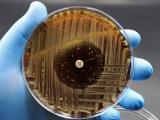A new study by an international team of scientists suggests that whole-genome sequencing could hold the key to more accurate and faster detection of antibiotic resistance and susceptibility in tuberculosis (TB) infections.
In an article published yesterday in the New England Journal of Medicine, members of the CRyPTIC Consortium and the 100,000 Genomes Project report that sequencing of more than 10,000 tuberculosis isolates enabled the correct prediction of resistance and susceptibility to first-line TB drugs with a degree of accuracy sufficient for clinical use. The authors of the study say their results indicate that DNA sequencing could be used to guide TB therapy in lieu of culture-based drug-susceptibility testing, an advance that could lead to quicker and more individualized treatment.
"To devise individualized therapies, a diagnostic assay is needed to determine which drugs to give, in addition to which drugs to avoid," they write. "These data show how our understanding of the molecular determinants of resistance to first-line antituberculosis drugs allows us to consider using DNA sequencing to guide therapy."
The results of the study were released during yesterday's United Nations High-Level Meeting on TB, where world leaders agreed to take action against drug-resistant TB as part of a larger commitment to ending the TB epidemic by 2030.
Genotypic predictions of resistance, susceptibility
To test how accurately whole-genome sequencing can detect susceptibility to first-line TB drugs, the investigators sequenced 10,209 Mycobacterium tuberculosis isolates from 16 countries across six continents. They were looking for mutations associated with resistance and susceptibility to the first-line TB drugs isoniazid, rifampin, ethambutol, and pyrazinamide in nine specific genes.
Based on the presence or absence of these genetic mutations, they predicted which isolates would be resistant or susceptible to the drugs. They then compared these genotypic predictions with the results of phenotypic, culture-based drug-susceptibility testing on the isolates.
Overall, predictions could be made for 93.6% of phenotypic test results indicating resistance and 93.5% of phenotypic test results indicating susceptibility. The results of the comparison showed that the sensitivity (the percentage of genotypic predictions of resistance that matched the phenotypic results) and specificity (the percentage of genotypic predictions of susceptibility that matched the phenotypic test results) were high.
For isoniazid, rifampin, ethambutol, and pyrazinamide, the sensitivity of genotypic prediction was 97.1%, 97.5%, 94.6%, and 91.3%, respectively, and the specificity was 99.0%, 98.8%, 93.6%, and 96.8%, respectively. In addition, of the 4,037 isolates that were predicted to be susceptible to all four first-line drugs, 97.9% were predicted correctly.
The authors note that the results, with the exception of the specificity results for ethambutol, exceeded the World Health Organization (WHO) accuracy standards for new rapid molecular TB tests, which require more than 90% sensitivity and 95% specificity.
The findings are significant because the rates of proper diagnosis and treatment for drug-resistant TB are low. Of the 600,000 estimated cases of rifampin-resistant or multidrug-resistant TB (MDR-TB) cases estimated by the WHO in 2016, only 22% were detected and treated with second-line drugs. Improper treatment can result in poor outcomes and lead to the spread of drug-resistant TB.
Part of the problem is that TB hits hardest in low-income countries with poor healthcare infrastructure, and traditional drug-susceptibility testing—which involves growing bacteria in culture and then exposing the bacteria to antibiotics—is expensive and time-consuming and requires trained healthcare workers. The introduction of a rapid molecular test (the Xpert MTB/RIF assay) has helped, but that test can identify only genetic mutations that confer resistance to rifampin.
The authors say that, with whole-genome sequencing getting faster and cheaper, using the technology for assessing drug susceptibility could mean more patients with drug-resistant TB being diagnosed and getting proper treatment.
"With ever-faster and more portable DNA sequencing technologies being developed, this advance means we are now much closer to delivering tailored therapy to TB patients around the world whose treatments have so far been largely based on a 'best guess,'" lead investigator Tim Walker, PhD, of the University of Oxford's Nuffield Department of Medicine, said in a news release from the National Institute for Health Research (NIHR) Oxford Biomedical Research Centre. "Giving the correct drugs to more patients will improve cure rates and help stop the spread of drug-resistant strains."
Impact on treatment outcomes
Experts say that remains the question—whether DNA sequencing can leader to better treatment of drug-resistant TB. The current success rate is around 54%.
David Dowdy, MD, PhD, an infectious disease epidemiologist at Johns Hopkins Bloomberg School of Public Health who studies TB, called the findings promising. "They suggest that we can use genetic data to predict susceptibility to first-line TB drugs, without having to wait to grow bacteria in a culture," Dowdy, who was not involved in the study, told CIDRAP News. "We still don't know how well these predictions will improve patient outcomes—that will be the next big advance—but this is an important step in the right direction."
A similar note was sounded in an accompanying editorial by TB experts Helen Cox, PhD, MPH, and Valerie Mizrahi, PhD, of the Institute of Infectious Disease and Molecular Medicine at the University of Cape Town.
"A more complete knowledge base enabling the prediction of resistance to all the drugs currently used for the treatment of MDR or rifampin-resistant tuberculosis is required in order to implement an approach whereby treatment can be rapidly individualized," Cox and Mizrahi write. "Although such an approach is expected to have potential benefits in terms of improved patient outcomes and reduced amplification of resistance, there is currently a lack of programmatic data that show the effect of this technology on clinical outcomes and that can clearly define its benefit."
Walker and his colleagues say that the next step will be to determine whether the genotypic predictions can be extended to second- and third-line TB drugs. But based on these results, Public Health England and public health agencies in the Netherlands and New York have already decided to stop culturing TB isolates that have been predicted to be susceptible to all first-line drugs.
See also:
Sep 26 N Engl J Med study
Sep 26 N Engl J Med editorial
Sep 26 NIHR Oxford Biomedical Research Centre news release
























